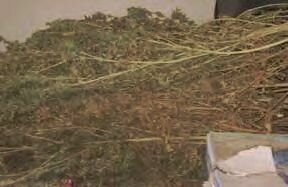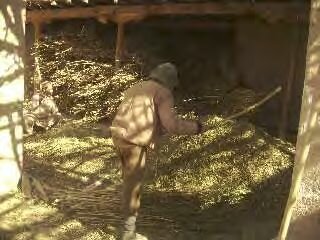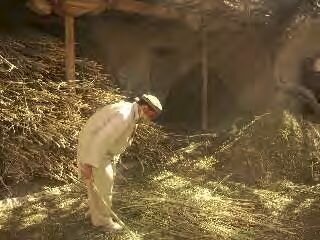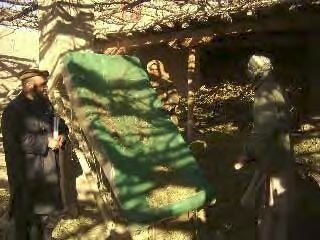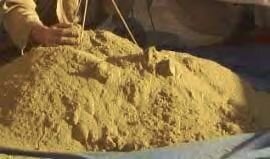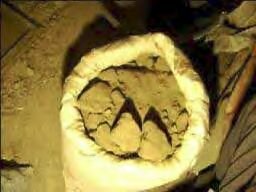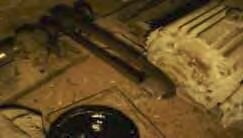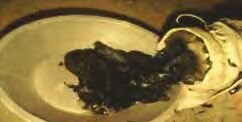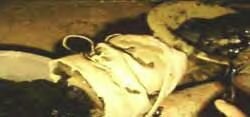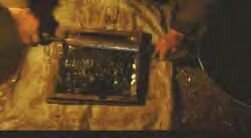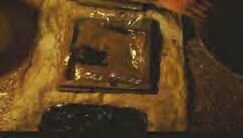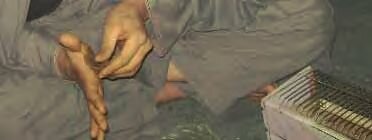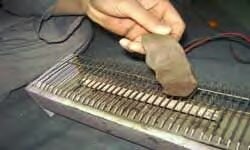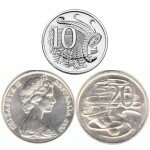Cannabis yield
The production of cannabis resin in Afghanistan involves several steps. First, farmers dry the harvested (cut) cannabis plants in the field and usually later dry them further inside the farm. The dried cannabis plants are threshed and sieved to produce a powdery substance locally called “garda”.
Garda consists of cannabis resin proper but also other plant material. The objective is to extract as much cannabis resin as possible. Through repeated sieving, farmers produce a graded quality which contains different proportions of cannabis resin. Cannabis farmers interviewed during the survey did not report production or sale of cannabis herb which is the upper part of the cannabis plant containing the floral cluster, often called outside Afghanistan as marihuana. However, this does not preclude the existence of small-scale production of cannabis herb.
Based on the quantity and quality of resin, garda is categorized as first garda, second garda and third garda. Fourth garda was only reported in a few instance in the south. The first garda is considered to be the best quality since it contains the highest proportion of resin. It is also more expensive than the second and third garda qualities. Laboratory test to determine the actual resin or THC content of different garda qualities were not part of this survey. Several garda extraction processes were observed and documented during the survey. Based on this observation, it seems very likely that lower garda qualities contain significant proportions of plant matter other than resin. It is not yet known how exactly farmers and traders determine the garda grade outside the counting of the number of sieving processes performed to extract the resin. The first, gentle shaking of the plant and sieving of plant material usually produces first garda, although the first garda may also contain products from further sieving.
Many cannabis farmers sell garda (resin) to traders but some also further process it into hashish, which is locally called “charas”. Hashish is the final product used for trafficking and consumption.
Mature female cannabis plant with resin glands

Mature female Cannabis plant with buds cultivated in North Afghanistan
Information from focus group interviews indicated that regional differences exist in processing cannabis into garda. For the purpose of estimating yield and production, provinces were grouped into two regions, North-Northeast-West (N-NE-W) and South-East-Central (S-E). In the North, Northeast and West of the country, the processing methods resulted with a higher quality but less quantity of first garda, whereas in the South and East, a larger production of first garda was obtain, but with a lower quality (less resin and more plant material).
The garda from the Northern region (Balkhi garda) contains more resin without the mixture of cannabis leaves, in contrast to the Central and Eastern regions, where during processing of the first garda, the farmers mix the cannabis leaves. In the Southern, Eastern and Central regions, the first and second yield collected are combined and considered as first garda. The third and fourth sieving were combined and considered as second garda and similarly for the fifth and sixth yield, which were considered as third garda. Hence the quantity of garda yield is higher in these regions.
Cannabis yield studies conducted by the Government of Morocco in 2004 and 2005 in cooperation with UNODC found much lower yields per hectare. The methodology to determine cannabis yield in Morocco consisted in harvesting cannabis plants and further processing them under controlled conditions in the traditional way used in the country, which also involved sieving. The yield was established as the extraction rate of cannabis powder from the harvested plant material, which was 2.82% in 2004 and 2.0% in 2005. One hectare of irrigated cannabis field in Morocco produced about 35.8 kg of cannabis resin in 2004 and 36.4 kg in 2005. According to the study, this includes cannabis powder of three different qualities, each representing about one third of the total production.
The comparability of the cannabis yield results from Morocco and Afghanistan is affected by methodological differences (field observations in Afghanistan vs. controlled off-farm measurement in Morocco) However, different processing and cultivation techniques, plant varieties and climatic conditions can explain part of the different yield results obtained in Afghanistan and Morocco which suggests that the two countries actually produce different cannabis products. The second and third garda produced in Afghanistan for example may be a product with very different properties of the cannabis powder produced in Morocco. Further investigations are needed to better identify what are the factors that can explain the large differences between the two countries.
Potential cannabis production
Total cannabis garda production, including all garda qualities, was estimated in 2009 between 1,500 and 3,500 mt. The estimation range reflects the range reported for the cannabis cultivation area. Most of the produced garda was of first quality. There are no standards across regions for garda qualities and garda of one quality type may not be homogenous. The survey did not investigate THC content or other chemical properties of the garda produced in Afghanistan and therefore its potency level is unknown.
Potential cannabis resin garda production, 2009
|
Region |
1st garda (mt) |
2nd garda (mt) |
3rd garda (mt) |
4th garda (mt) |
Rounded total (mt) |
|
Lower limit |
693 |
471 |
287 |
19 |
1500 |
|
Upper limit |
1648 |
1120 |
683 |
45 |
3500 |
|
As % of total garda |
47.00% |
32.00% |
20.00% |
1.00% |
100.00% |
Garda processing
At least two farmers are involved when producing the garda. At the beginning, they hit the dried cannabis plants on a barrel (drum) to separate the buds from the main branches. Then, they collect the cannabis powder (product) onto a heap inside a room. After separating the dried buds and leaves, they use the remaining plant branches as cooking fuel. They also separate the seeds, after which they sieve (filter) the product through a wooden frame (cot) kept in an inclined position. Two persons sieve the garda: one collects the product by the shovel and spreads it over the cloth on the cot, assisted by the second person who helps to spread the dust evenly, using the hands. After sieving, they put the product in a bag made of cloth. The two persons hold the bag at the ends and shake the bag for about 5 minutes. Most of the dust is filtered out during this process. The sieving takes place three times. The remaining powder is split and put into smaller bags. A small quantity of powder is put in a cloth pouch and beaten by hand to remove the remaining dust. Thus, the final garda contains mostly resin called first garda. The first garda in the Northern region processed in this traditional way is considered to be the best quality and to contain a high proportion of cannabis resin. It is also known as Jooshi or Balkhi garda. It was reported that 25 kg of “normal” first garda produces only about 14 kg of Jooshi garda.
Most farmers usually sell the garda (resin) in its powdery form. The garda (resin) powder is not yet ready for consumption, and another transformation is needed to convert garda powder into hashish. This transformation is usually done by traders.
Stages of cannabis garda production
|
|
|
|
|
|
|
|
|
Hashish production
The information collected during the survey, suggests that the amount of hashish produced from 1 kg of cannabis garda vary across regions probably due to the different hashish production methods utilized. Traditional methods of hashish production from high quality garda powder typically generate a 1:1 ratio, with no weight loss in the transformation process from garda to hashish. Weight loss, which was reported occasionally, does probably occur due to a final “dusting” of the garda to get rid of unwanted plant material and other matter, and is not a result of the conversion of garda in to hashish as such. Weight gain could also occur, when water is added to facilitate the consolidation of cannabis garda powder into a paste or mass that can be heated. Further research is needed to better understand if and to what extent such weight gain occurs, how widespread it is, and if the added water evaporates (partly) later in the process.
With the current knowledge of the different hashish production methods used in Afghanistan, some of which are explained in more detail below, it is reasonable to assume a 1:1 conversion rate of cannabis garda into hashish.
Traditional hashish (charas) production
To make hashish from Jooshi garda, a farmer puts a handful of powder on his palm and lights a match. Another farmer slowly sprinkles some powder on the top of the flame. During this process, the powder gets heated The process is repeated a couple of times, until the product becomes soft, sticky and solid. The resin is pressed and rolled by hand until the product becomes soft. Then, the solid mass turns into a greenish brown product. This product is called Jooshi hashish (charas). This traditional process is time consuming, but because of its quality, demand for this product is reportedly high, and it can be sold at high price. Jooshi hashish is also known as Balkhi hashish or Sherak-i-Mazar (milk of Mazar).
Hashish production by machine
|
|
|
|
|
|
|
|
|
|
|
|
Hashish production by machine
The mechanized preparation of larger quantities of hashish seems to be a more recent development. This machinery observed during the survey comes from Pakistan and can, reportedly, process the product (garda) from one jerib land (0.2 ha) in 4-5 hours. It consists of a main part (funnel) where the garda is fed into from the top. A rotating/kneading spiral shaft is connected to an electric motor. The garda powder is continuously fed from the top and churned inside.
The kneading and churning action heats the garda and converts it into a thick, dark brown paste. This paste is reprocessed by feeding it for a second time into the machine to achieve a homogenous hashish paste. The hashish paste is then put into a wooden mould and spread uniformly using a roller, while covering it with a plastic sheet. According to anecdotal information, this kind of machinery is currently only used by traders, not by farmers.
Manual hashish production in the Southern region
A small amount of garda powder is pressed with the palms of the hand. Good quality garda (first garda), which is rich in resin and has “oily” components, gets sticky and consolidates when pressure is applied by rubbing it between the hands. No other ingredients are needed in this case. However, some water is added to garda powder of lower quality with a lower proportion of resin and oily components, to increase cohesion and facilitate its consolidation.
Then, the garda mass is heated over a low flame, sometimes referred to as ‘cooking”, which converts it into hashish. There can be several rounds of rubbing, heating, and rubbing again until a piece of garda mass is “cooked”. The addition of water in the process of hashishmaking from low quality garda adds weight but some of the water may evaporate later on through the repeated heating and rubbing. This type of hashish preparation is done on a small scale and mostly used by local traders and sporadically by local drug users.
Stages of manual hashish preparation from garda powder
|
|
|
|
|
|
The Afghanistan Cannabis Survey 2009 was financed by the United States of America. UNODC’s illicit crop monitoring activities in Afghanistan were made possible by financial contributions from the Governments of Germany, Norway, the United Kingdom and the United States of America.
Excerpt from: Afghanistan_Cannabis_Survey_2009.pdf
